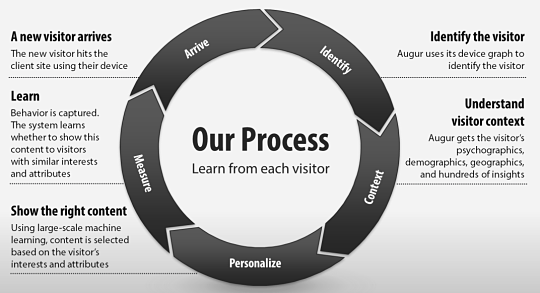Startup Augur helps website owners to identify anonymous traffic, get deep insights on existing end-users, and personalize their content experience. Below is interview with Nawar Alsafar Founder and CEO of Augur.
Q: What is Augur and how does it work?
A: We believe the future of the internet is having every app we use personalized to us. Everything from the browser to mobile to wearable hardware is becoming increasingly personal every single year. We’re already seeing the world’s most popular properties like Twitter, Google search, Facebook, LinkedIn, Amazon, Yahoo, etc., serve each user a custom version of content. We know personalization is the future, but our concern is this technology is only available to companies like Google, or companies who can afford enterprise-level pricing. Our goal is to make personalization available to anyone who wants to use it – we’re taking what Google has and making it available to everybody. That’s why we created Augur. Augur is the power of Google, Amazon, Yahoo, etc. for a fraction of the time, effort, and cost. Augur is Plug and Play Personalization.
We designed Augur to be simple and focused:
– Personalizes the digital content experience
– Provides deep insights on digital customers
– Is easy to install and manage
To use Augur just: Install it (paste augur.js into a site’s head like Google Analytics), Input content (via API or a visual editor), press play and you are done!
From there, the site will automatically become personalized to each user. Everything is automated in the background.
One of our insights was not to use how someone clicks around in an app to predict who they are and what they care about (which is what everyone does), but to instead use how they behave across the internet (what they blog about, tweet about, etc) and they’re in-app behavior to get a better picture of who someone is and what they care (and don’t care) about. We personalize based on internet-wide behavior.
Under the hood, we use a large-scale machine learning algorithm we developed. In a way, we combined the concepts behind a contextual bandit algorithm (how search engines contextualize ads based on your search), a Kalman filter (an algorithm used in the Google self-driving car), Vowpal Wabbit (fast machine learning), and me modified them to use someone’s internet wide behavior in predictions. We call our algorithm Auspice, and it’s kinda like an evolving Markov chain. We also use a device graph instead of cookies to identify anonymous traffic, with the intent of making sure they only experience relevant site content.
Q: Are you looking for partnership opportunities or VC funding?
A: We’re open to opportunities and partnerships.
Will we ever raise a VC round? We’d like to. We’ve believe there’s a gold mine in what we’re doing and we’d like to connect to more networks, advisors, industry partners, and experienced players. We’d like to raise a humble seed round, not a large round, because the cost of capital is high for early stage companies.
Today, we have almost 1,400 companies signed up. Our goal is to prove our product is very sticky. Once we do that, we can raise a larger ($1-to-1.5M) round at a lower cost to the company. Execution is nothing more than excellent sequencing. We want to make sure we bring Series A VCs into the picture at the right time and at the right step.
Q: How does Augur plan to generate revenue? What’s your monetization plan?
A: We have two revenue models on the table. The first is transactional and the second is geared towards digital agencies (we have many agencies signed up for our software).
In web analytics, there is a common metric known as Unique Visitors per month. It means how many people actually came to the website that month. We plan to charge $0.01 USD per a Unique Visitor and bill monthly. If a site has 10,000 customers in a month, we’d charge $100. If they had 2.5 million visitors a month, we’d charge $25,000. If they had 100 customers, we’d charge $1. Seems simple, buts it’s actually quite brilliant economically. We’re actually selling digital data. We have a one-time, fixed cost of $0.00005 to produce that data and we sell that data back to customers at $0.01 every single month, meaning we have a huge gross profit margin, every month. So far, every company we’ve spoken with has accepted this revenue model because it’s fair…which means we’re underpricing, but that’s okay, we’re not price optimizing at the moment. That’s not the metric that matters to us right now.
The other model is meant for digital agencies. Their clients retain them. They bill clients based on campaigns. Transactional (variable) pricing may complicate their client billings; so instead, we may charge them a fixed price to use our software with their client for particular campaigns, or use MACs (minimum annual commitments).
Ultimately, I believe in Amazon’s model. Go for volume on slim margins. Then, flip a switch one day and be massively profitable. Playing with volume is more fun.
Q: What was technically the most challenging part of developing it?
A: Well, we had to solve the following problem – figure out what content anyone is most likely to click on based on how they behave across the internet, in 1 to 3 milliseconds. The solution has to be lightning fast, so the human eye can’t perceive any changes in content.
It turns out there isn’t much literature on large-scale machine learning or mass contextualization…let alone on bleeding edge, best practice. I had to push my personal bounds of learning, studying, and organization to make it happen. After you write enough math on walls and tables, you eventually get it. I believe anyone can do anything, if they so choose.
Q: How would you describe biggest benefits of using Augur?
A: We’ve made something really complicated and expensive, really easy and affordable!
Last Updated on MAY 21, 2014
Activate Social Media:





